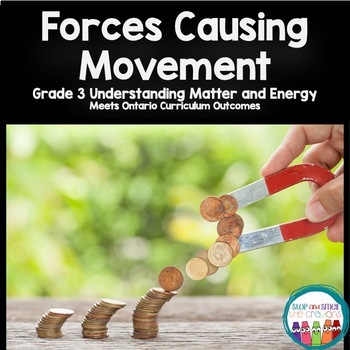Grade 3 Science Forces Causing Movement | 3rd Grade Science Forces and Motion
- PDF
What educators are saying
Also included in
- Looking for a streamlined, comprehensive way to teach your grade 3 science lessons? Look no further! This complete, 3rd grade science bundle has everything you need to keep your students engaged all year long! Take the stress, overwhelm and hours of planning out of your year with this engaging resouPrice $26.97Original Price $52.00Save $25.03
Description
Are you looking for a fun and engaging way to teach your 3rd grade science students all about the forces and movement? Look no further! This Forces and Motion science unit covers everything your grade 3 science students need to know to master all concepts related to forces causing movement. This resource extensively covers friction, push/pull, muscular force, gravity, forces of nature, magnetic force, static force and so much more to prepare your 3rd grade science students for matter and energy outcomes. This 74 page movement science unit comes with lessons designed to meet curriculum expectations, full color posters and vocabulary word cards, book suggestions, full colour slides to project during lessons, vocabulary books, experiments, reading comprehension activities and an end of unit assessment to test understanding of forces causing movement! Take your grade 3 science planning to the next level with this complete movement science unit and watch your students thrive!! Please check out the PREVIEW to see all that is included in this amazing resource!
CLICK HERE FOR AN INCREDIBLE DEAL!!
PRIMARY SCIENCE BUNDLE - 75% off - GET GRADE 1, 2 & 3 BUNDLES for $34.97
Forces and Motion for Grade 3 Science includes lessons on the following key concepts:
- Friction
- Push/Pull
- Muscular Force
- Gravity
- Forces of Nature
- Magnetic Force
- Static Force
- and much more
❤️ See What Teachers Are Saying ❤️
- My students loved the experiments included in this resource! They had such a great time, and really increased their understanding of forces causing movement! I would definitely recommend this resource to others!
- This is a comprehensive unit with lessons, experiments, book suggestions, and consolidation activities. I highly recommend it and will be purchasing the structures unit next.
- This resource is amazing. I love how the lesson plans are set out and it was easy for me to follow along when planning my own lessons. I also like how there is a list of books attached that I can use to supplement my lessons. Fantastic resource!
☟ MORE FUN AND ENGAGING GRADE 3 SCIENCE ☟
Follow me on Teachers Pay Teachers and get notified of new resources and sales!
Let’s Connect:
Stop and Smell the Crayons Website
Find me on Instagram and Facebook
Terms:
Copyright © Laura Merritt – Stop and Smell the Crayons (TpT) All rights reserved by the author. This product is to be used by the original downloader only. Copying for more than one teacher, classroom, department, school, or school system is prohibited. This product may not be distributed or displayed digitally for public view. Failure to comply is a copyright infringement and a violation of the Digital Millennium Copyright Act (DMCA). Clipart and elements found in this PDF are copyrighted and cannot be extracted and used outside of this file without permission or license. Intended for classroom and personal use ONLY. See product file for clip-art and font credits.





